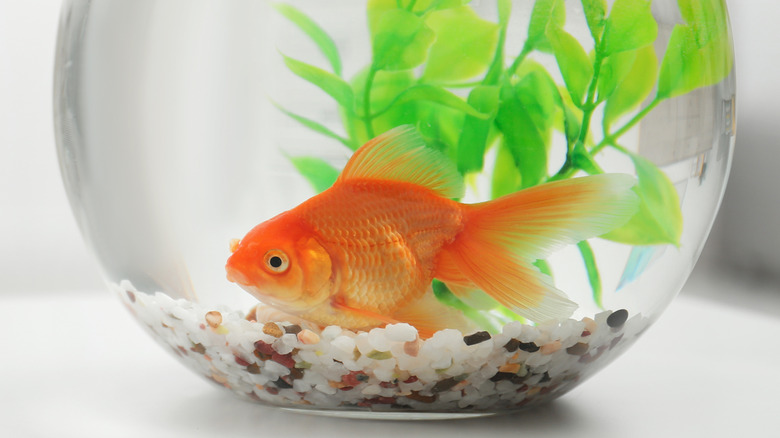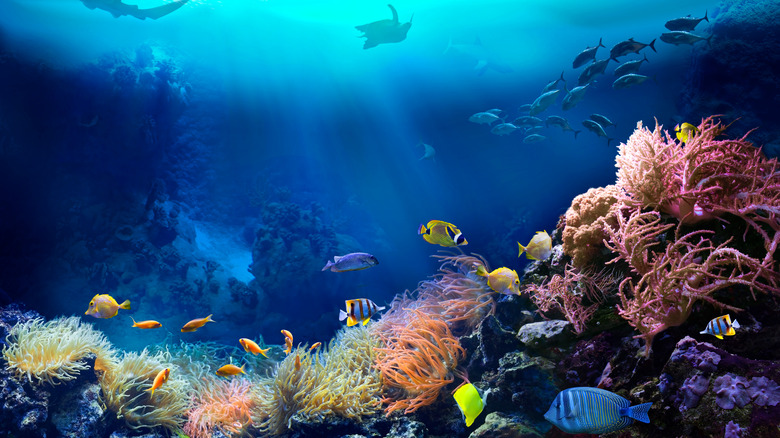TikTok Is Stunned By This Goldfish Who Knows How To Drive
When it comes to the internet, many of us may feel like we've already seen it all, and then some. Although we may have access to a whole world of knowledge at our fingertips, many of us resort to watching people dancing and dogs being cute on TikTok instead of exploring the latest scientific developments. No judgment, by the way — watching dog videos is a very appropriate way to spend your leisure time. But what if you could get both from your daily dose of TikTok?
This time around, Motive Future on TikTok blew the minds of hundreds of thousands of users by sharing a video of a goldfish that was able to learn how to drive. No, you didn't misread. The goldfish, equipped with specialized tech, was successfully trained by a team of scientists to drive a vehicle. Of course, none of us have to worry about some sort of a goldfish revolution where our pets suddenly all learn how to drive our cars and eventually take over the planet. Let's leave the (mildly successful) hands-off driving ventures to electric vehicles like Tesla.
The so-called fish car, officially referred to as a fish-operated vehicle (FOV), is the result of research conducted at the Ben-Gurion University of the Negev in Israel. Aside from conquering TikTok, the research delivered many interesting findings about goldfish, the ways in which they learn, and the capabilities they possess.
Fish tank on wheels
In the video, the goldfish is shown completing one of the tests the scientists created for training purposes. We get to see the fish-operated vehicle in its full glory, and in all fairness, it's not that impressive. It's essentially a square-shaped tank filled with water for the fish to remain safe as it drives, and it's attached to a set of wheels combined with the technology that makes driving it possible. The whole thing kind of resembles the character of AJ Carmichael from "The Umbrella Academy" who has a high-tech fish tank for a head. The FOV moves from one side of the room to the next, clearly aiming for the pink sign that hangs on one of the walls. This, too, is part of the training the fish had gone through up until that point.
Many animals, goldfish included, have to carefully navigate their environments in order to find sustenance and shelter. For fish, this includes dodging obstacles, especially in a coral reef setting where the fish have to swim around and optimize their route to avoid hitting the reef. The scientists from the Ben-Gurion University wanted to learn whether a fish can be taught to navigate with similar precision on land. Because they can't survive out of water, the FOV was created to let the fish control its route while swimming toward a goal and avoiding the obstacles that were later placed in its path. For this test, six goldfish were trained to drive the FOV.
The goldfish were easy to train
Surprisingly, the training was easy, though instructing a goldfish is far different than teaching your dog how to sit — you can't train it to listen to your commands. However, you can teach a fish that when it swims in a certain direction, it will be rewarded with a treat. At first, the fish swam around without forming any kind of pattern; erratic and devoid of any plan, it behaved like any goldfish in a bowl would. The FOV faithfully mimicked its movements. Eventually, the goldfish recognized a pattern, and the tank's movement slowed down in a way that could be considered deliberate.
The next step was for the scientists to teach the goldfish to recognize its environment and make decisions based on what was ahead. To do that, Shachar Givon, a doctoral student at the university, decided to take things up a notch together with her colleagues involved in the research. As a result, a piece of pink cardboard was placed on the floor away from the fish. Whenever the fish successfully drove over the square, it was rewarded with a treat.
It took some time, but the fish mastered this and after a few days was able to swim directly over the pink cardboard and straight for the treat. This prompted the scientists to create something akin to an obstacle course, with things to dodge and fake targets to avoid hitting. Eventually, all six fish were able to master this and dart for the treat right away.
TikTok thinks the fish did a better job than many people
The findings of the research team from Israel suggest fish are, indeed, capable of learning and navigating new environments that do not resemble their natural habitat. The study is not over yet, though. The next step is for the fish to navigate outside of the room and into the campus, adapting to yet another environment. All of the team's findings have been published online in the journal "Behavioural Brain Research."
Seeing a fish semi-consciously drive a vehicle is fascinating, but of course, it would not be TikTok if the comments were not flooded with jokes. Many users were eager to take the chance to make a joke about human drivers in various locations, implying this team of scientists may one day be able to help them out, too. "You guys joke, but this is groundbreaking research. Scientists estimate they could teach people in California to drive by the end of 2035," said one TikTok user as a response to the video. "Drives better than a lot of people," added another commenter.
The research may not seem outstanding in the grand scheme of things, but it definitely brings value in terms of finding out how fish navigate their environment. In any case, it's both endearing and cool to watch a little goldfish drive a vehicle all on its own, so this is one of those great TikTok findings that are worth cherishing.



